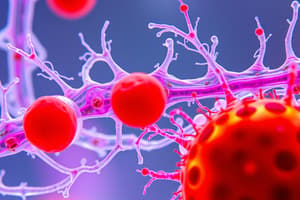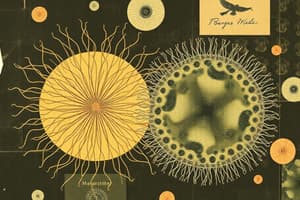Podcast
Questions and Answers
Which statement accurately describes cells?
Which statement accurately describes cells?
- All cells possess a membrane that encases cytoplasm and contains biomolecules. (correct)
- Cells do not vary in size across different species.
- Cells are composed of organelles that function independently from the cytoplasm.
- Cells are only found in multicellular organisms.
What distinguishes unicellular organisms from multicellular organisms?
What distinguishes unicellular organisms from multicellular organisms?
- Unicellular organisms are always visible under a light microscope.
- Unicellular organisms consist of a single cell, while multicellular organisms consist of multiple cells. (correct)
- Unicellular organisms exhibit a greater complexity of structures.
- All unicellular organisms are categorized as viruses.
What is the typical size range of most plant and animal cells?
What is the typical size range of most plant and animal cells?
- 1 to 100 micrometers (correct)
- 10 to 100 millimeters
- 100 to 1000 micrometers
- 1 to 10 nanometers
How can most unicellular organisms be characterized?
How can most unicellular organisms be characterized?
Which of the following statements is NOT true regarding cells?
Which of the following statements is NOT true regarding cells?
What is a characteristic feature of cells?
What is a characteristic feature of cells?
Which statement accurately describes unicellular organisms?
Which statement accurately describes unicellular organisms?
What is the typical size range for most plant and animal cells as seen under a light microscope?
What is the typical size range for most plant and animal cells as seen under a light microscope?
How are multicellular organisms primarily classified?
How are multicellular organisms primarily classified?
Why are most unicellular organisms classified as microorganisms?
Why are most unicellular organisms classified as microorganisms?
Flashcards are hidden until you start studying
Study Notes
Cell Biology
- The study of cells.
- Cells are enclosed in a membrane and contain cytoplasm.
- Biomolecules such as proteins and nucleic acids can also be found in cells.
- Most cells are only visible under a light microscope.
- Cells are typically between 1 and 100 micrometers in size.
Organisms
- Organisms can be classified as unicellular or multicellular.
- Unicellular organisms are made up of a single cell, such as bacteria.
- Multicellular organisms include plants and animals.
- Most unicellular organisms are microorganisms.
Studying That Suits You
Use AI to generate personalized quizzes and flashcards to suit your learning preferences.




